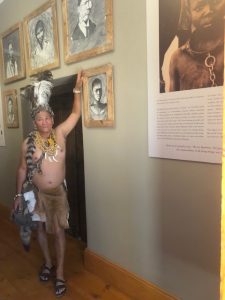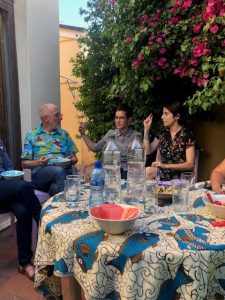
Today, December 3, is International Day for People with Disabilities. What does it mean to have an international disability day? For those I have spoken to in the U.K., Europe, Australia and South Africa – being named means being seen, valued, represented. We know the impact on black citizens in the U.K. before black actors appeared on television. What does it mean to see no one like you in magazines, comics and films? For your name or your condition only to be known in hospitals? To have therapy and not play? In America, one disability rights groups called “ordinary” people the “temporarily unimpaired” which I find extremely helpful- it has the deep truth that humour provides. Joanna, aged 15, when asked about this day, said “It is my day. You have Mother’s Day and Father’s Day and my birthday but disability is all of us – people in wheelchairs with good brains and me who can walk with half a brain”. And what of our language for this International Day? The word “Disability” has not caused furore in the way “handicap”, or even more stigmatising language such as ‘retarded’ and ‘subnormal’ has done. It is worth reflecting that when a label changes every few years we know, psycho-linguistically, that something is not bearable. Subnormal to handicap to special needs to learning difficulty to intellectual disability. . .

As we celebrate this International Day for People with Disabilities, I am in South Africa, where the population deal with mass illiteracy and a significant number, through social-political trauma, develop mild intellectual disability. When I was first invited in 1994 to help address this process, painful issues emerged. Many township mothers had refused to let their children become literate, fearing they would be made to sign false confessions by apartheid police. Slowly, as a result of Mandela’s influence when he was freed, this lessened. However, the system of making a child who was educationally “behind” repeat a year in school continues to shame and damage progress. Additionally, although Mandela banned the beating of children, and that is enshrined in law, schools continue to do this illegally.
Outside of major centres of excellence there are little resources for disability services. However, Cape Town is blessed with a fine psychology training at UCT and projects to help children and adults with intellectual disability are world class, despite the lack of resources and the enormity of the problem. Brian Watermeyer, a lecturer there, is visually impaired and uses his experience of his own disability to aid his clients. Professor Leslie Swartz of Stellenbosch University, together with his Cape Town and Lenteheur hospital colleagues, created a joint disability International Day on December 1st, where I had the privilege to present a half-day workshop and provide supervision. How does all this relate to our field? Tragically, people with disability are much more likely to experience abuse, with the highest rates being among those with intellectual disability. In addition, the impingement on attachment, due to depression in parents, and the bodily and mental discomfort in the child leads to an extra vulnerability.
In a world where there is impatience and fear over non-comprehension, slowness and deformity, it is not surprising that behaviours that come from trauma such as self-injury and rocking are seen as an innate part of disability and therefore ignored. In fact, these groups have high rates of unacknowledged and untreated trauma and dissociation. Kate McMaugh, an ISSTD Member, who has worked within both disability and trauma services in Australia, said to me, when talking of her experience in disability services: “I was amazed by the amount of complex trauma amongst this group of people. People often lack the ability to speak out, yet they have certainly had a lot of abuse. Often it is the carers or group home staff, who know the clients really well, who get told of the abuse – sometimes decades later and often only in ways that people close to them can understand. One of my clients had such idiosyncratic sign language and severe speech problems that only those who knew her really well would understand her story. When I got to know her she was able to say (actually ‘sign’) that her father touched her in the shower, that he was bad, that he showed her his penis and even more detail. Yet 99% of people on the planet could not understand her communicate. I felt so sad that so many of these clients never got the care they needed, or the therapy they needed. But I know they do respond to counselling – it might be slower or we might need to use creative methods, but it can work.”

To illustrate just what is possible I will discuss a case of mine, Eve, aged 19, who had profound multiple disability and was paralysed from her waist down. She was blind in one eye from eye poking and had a collapsed bowel from anal poking. She had no verbal or sign language and yet she was able to communicate the deepest issues. Abandoned at birth and moved from home to home where no records were left, she was referred from a community home who noted she screamed most at Christmas, which was when she was abandoned. Every night the staff put her to bed and, with no 24 hour shift, they would find her the next morning, covered in feaces, with the walls all smeared. Smearing of menstrual blood occurred each month.
After two years of therapy, where I would wonder aloud about what I was observing, her self injury lessened, yet there was a wish to sterilise her to avoid the moods that came with her period, as well as the menstrual smearing. In one session, sitting on her wheelchair, she pulled down her tights and a little drop of menstrual blood fell on the floor. I felt enormous sadness. I said: “Why Eve- all this time we have worked together you didn’t want me to know you were a woman with a period, which means you are not pregnant.” She pointed to a baby doll and I passed it to her. She threw the doll on the floor and a tear ran down her cheek. I said she had been thrown away by her mother as a baby and here she was in the room, a woman without a baby. But also – here we were two women in the room and she was my therapy baby, as well as a woman without a baby. She pointed for the doll and hugged it and then drew the tree from the front garden. I said the tree would be there after we had died and how comforting she found it. That night there was no smearing and all calls for an operation stopped. Later she was able to reveal anal rape.
In other words, this case shows that psychoanalytically informed therapy can be applied to extreme disability. The only difference in application was to show more affect in face and voice rather than “neutrality”. When I discussed this with Kate, she mentioned how important it was for her, working with people with intellectual disability and brain injury, to be trained in augmentive and alternative communication strategies, such as key word signing or Boardmaker. When needed, these extra communication tools are typically not that difficult to learn. Kate said:

“Since many people with disability need an individual communication approach, a therapist can actually learn this communication as part of getting to know the client. I believe specialist trauma and dissociation therapists would be complete naturals at working with traumatised individuals who have a disability, as they are already used to individual and creative approaches.” Where someone has intellectual disability and DID, the process of treatment is harder. Judy Williams from the U.K., Aafke Scharloo from The Netherlands and I have presented on this dilemma at past ISSTD conferences. Again, access to treatment is crucial and people with this double disability can be helped. Extra time is needed to help process the complexity of this double situation.
For example, Jon, the male alter in a 30 year old woman, found “inside” and “outside” even more intellectually difficult to grasp. He wept for his “lost” penis when he came out and his level of intellectual capacity made the predicament of DID unbearably complex. He felt his carer or therapist must have magically removed it. This led to violence until turning the light switch on and off created a clue for him as to how different states co-existed. Once this was identified he was able to make progress. The good news is that therapy and meaning work for people with all levels of disability, whether with or without DID. Valerie Sinason PhD, is a child and adolescent Psychotherapist and an adult psychoanalyst. She is chair-elect of ISSTD’s RAMCOA Special Interest Group. She was recipient of the ISSTD lifetime achievement award in 2016. In the U.K. she was Founder of the Clinic for Dissociative Studies and Founder President of the Institute for Psychotherapy and Disability. She is the first recipient of the IPD Valerie Sinason award. Books Intellectual Disability and Psychotherapy: The Theories, Practice and Influence of Valerie Sinason, Ed Alan Corbett (2018) has just been published by Routledge. See NYCU this month for more information. Sinason,V (2012) Mental Handicap and the Human Condition; an analytic approach to intellectual disability, Free Association Books

